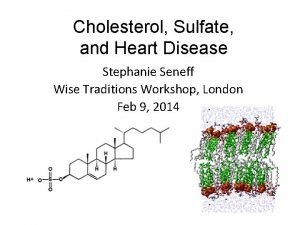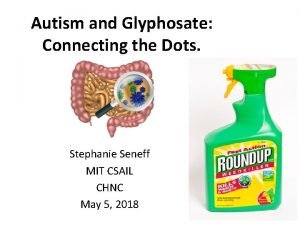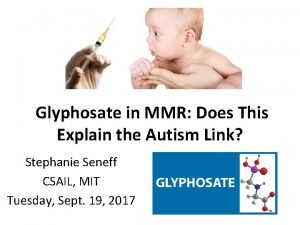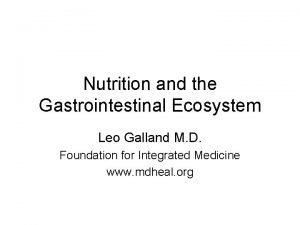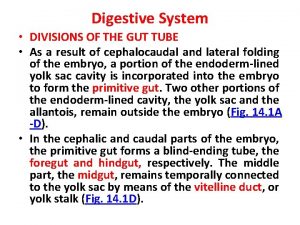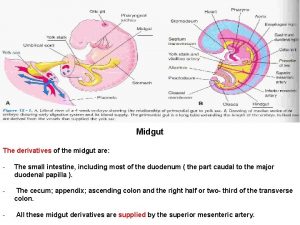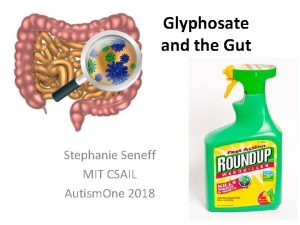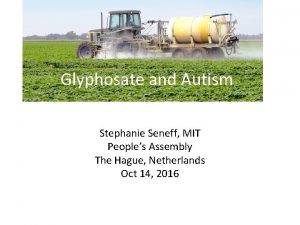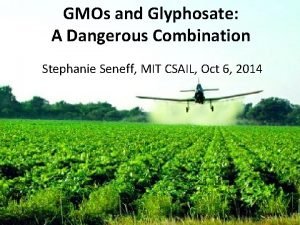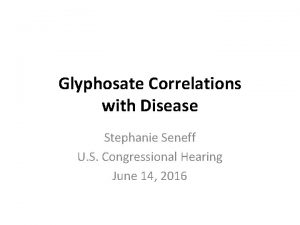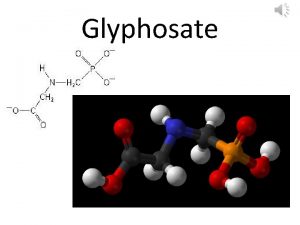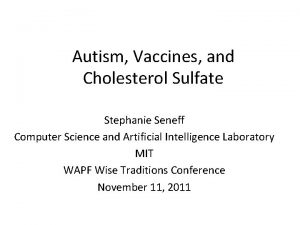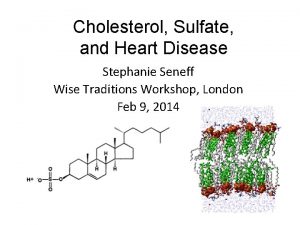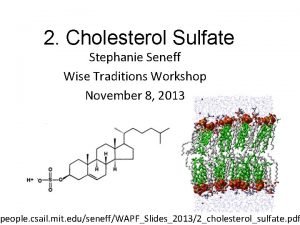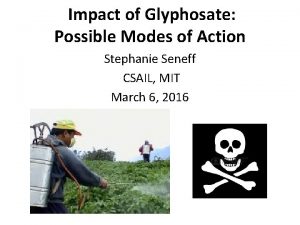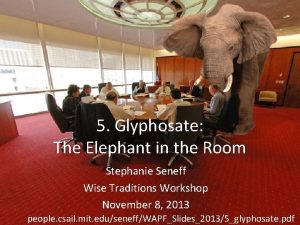Glyphosate and the Gut Stephanie Seneff MIT CSAIL





























- Slides: 29

Glyphosate and the Gut Stephanie Seneff MIT CSAIL Autism. One 2018

Outline • • • Autism and Gut Issues Pathogen Overgrowth Digestive Enzyme Impairment Celiac disease Antibiotic Resistance BTBR Mouse model of Autism Impaired CYP enzymes and Bile Acid Synthesis Impaired Myosin and Peristalsis Clostridia Overgrowth and Autism Summary

Autism and the Gut* “Prospective, controlled studies suggest that as many as 70% of autistic children exhibit chronic GI-related symptoms [1, 5, 6] including diarrhea, laxative-dependent constipation, abdominal distension, failure to thrive, weight loss, feeding problems, and abdominal pain related to extreme irritability, aggression, and self-injury. ” *SJ Walker et al. PLOS One March 2013; 8(3): e 58058.


Glyphosate and the Gut: Pathogen Overgrowth • Glyphosate is an antimicrobial agent that preferentially kills beneficial microbes, allowing pathogens to flourish in the gut* • Immune cells invade the gut and release inflammatory cytokines – This causes increased risk to inflammatory bowel diseases such as Crohn’s and ulcerative colitis * Samsel and Seneff. Entropy 2013; 15: 1416 -1463.

Pathogen Overgrowth in Poultry Microbes Exposed to Glyphosate* Clostridia Salmonella Bifidobacteria *Plot provided by Dr. Martin Michener

Glyphosate and the Gut: Digestive Enzymes • Glyphosate has been found as a contaminant in digestive enzymes trypsin, pepsin and lipase* • Trypsin impairment prevents proteins like gluten in wheat from being digested • Undigested proteins induce release of zonulin which opens up gut barrier** • Zonulin lingers because trypsin is defective *A Samsel and S Seneff. J Biol Phys Chem 2017; 17: 8 -32 ** JJ Gildea et al. J Clin Nutr Diet. 2017, 3: 1.

Trypsin, Pepsin and Lipase are all contaminated with glyphosate* Enzyme Pepsin (ELISA) Pepsin (GC-MS) Pepsin (HPLC-MSMS) Trypsin (ELISA) Lipase (ELISA) Glyphosate (PPB) <40 430 290 62 24 *A Samsel and S Seneff. Journal of Biological Physics and Chemistry 2017; 17: 8 -32

Glyphosate is a non-coding amino acid analogue of glycine H Glycine Glyphosate

Glyphosate is a non-coding amino acid analogue of glycine Glyphosate substitution by mistake for glycine during protein synthesis could explain glyphosate contamination in trypsin H Glyphosate

Trypsin, Pepsin and Lipase are all contaminated with glyphosate* Trypsin’s activation domain contains four crucial glycine rich subdomains: * N-terminus to Gly 19 Gly 142 to Pro 152 Gly 184 to Gly 193 Gly 216 to Asn 223 *A Samsel and S Seneff. Journal of Biological Physics and Chemistry 2017; 17: 8 -32

A Scenario for Gluten Intolerance Leaky brain barrier Autoimmune neurological disease Zonulin Glyphosate in wheat Trypsin defective Zonulin released Gliadin Systemic immune response induces multiple complex symptoms Leaky barrier

Glyphosate and Celiac Disease* Glyphosate Use on wheat Celiac disease *Samsel and Seneff, Interdiscip Toxicol. 2013; 6(4): 159– 184.

Celiac Disease, Glyphosate and Non Hodgkin’s Lymphoma • Glyphosate preferentially kills Bifidobacteria* • Bifidobacteria are depleted in celiac disease** • Celiac disease is associated with increased risk to non Hodgkin’s lymphoma*** • Glyphosate itself is also linked directly to non Hodgkin’s lymphoma**** *A. A. Shehata et al. , Curr Microbiol. 2013 Apr; 66(4): 350 -8. ** M. Velasquez-Manoff, NY Times Sunday Review, Feb. 23, 2013. *** C. Catassi et all, JAMA. 2002 Mar 20; 287(11): 1413 -9. ****M. Eriksson et al. , Int J Cancer. 2008 Oct 1; 123(7): 1657 -63.

*Figure 20, NL Swanson et al. Journal of Organic Systems 9(2), 2014, p. 25.

Glyphosate Induces Antibiotic Resistance* • Actinobacteria produce a free radical scavenger in response to glyphosate that provides resistance to a wide range of antibiotics, including penicillin • E. coli exposed to glyphosate develop an "efflux pump" that increases resistance to the fluoroquinolone Ciprofloxacin and the aminoglycoside Kanamycin. – Same effect observed in Salmonella exposed to glyphosate *AHC Van Bruggen et al. Science of the Total Environment 2018; 616 -617: 255– 268.

Glyphosate Usage and Papers on Antibiotic Resistance* *AHC Van Bruggen et al. Science of the Total Environment 2018; 616 -617: 255– 268.

A BTBR Mouse Model of Autism* These mice had all the mouse features of autism They were fed “standard rodent chow” – glyphosate contaminated? Some features in the gut: • Reduced levels of bile acids (due to impaired CYP 7 A 1 activity in the liver) • Further reduced levels of secondary bile acids (impaired metabolism by gut microbes) • Reduced levels of Lactobacillus and Bifidobacteria (microbes that metabolize bile acids) – These microbes are preferentially killed by glyphosate • Serotonin deficiency (due in part to tryptophan conversion to kynurenine to fight infection) – Serotonin is derived from tryptophan, a product of the shikimate pathway which glyphosate disrupts *AV Glubeva et al. EBio. Medicine. 2017 Oct; 24: 166 -178.

Glyphosate Disrupts Cytochrome P 450 (CYP) Enzymes* • Glyphosate has been shown to severely suppress CYP enzymes in rat liver • CYP enzymes have a unique FXXGXRXCXG motif with two and sometimes three critical glycine residues** GLYCINES *A Samsel and S Seneff. Entropy 2013; 15: 1416 -1463. **K Syed and SS Mashele. PLOS ONE 2014; 9(4): | e 95616.

Glyphosate Disrupts Cytochrome P 450 (CYP) Enzymes* • Glyphosate has been shown to severely CYP enzymes suppress CYP are needed to produce bile acids for digesting to activate vitamin D and to enzymes in ratfats, liver detoxify many toxicants • CYP enzymes haveenvironmental a unique FXXGXRXCXG motif with two and sometimes three critical glycine residues** GLYCINES *A Samsel and S Seneff. Entropy 2013; 15: 1416 -1463. **K Syed and SS Mashele. PLOS ONE 2014; 9(4): | e 95616.

BTBR mice have low acetate, and glyphosate disrupts acetate synthesis in gut* BTBR mice Children with autism had only 3. 5 mg/ml acetate in stool samples compared to 5. 1 in controls. ** *LN Nielsen et al. Environmental Pollution 2018; 233: 364 e 376. **Adams et al. BMC Gastroenterology 2011; 11: 22.

BTBR mice have low acetate, and glyphosate disrupts acetate synthesis in gut* Children with autism had only 3. 5 mg/ml acetate in stool samples compared Elevated p. H linked to glyphosate exposure results in to 5. 1 in controls. ** small intestinal bacterial overgrowth (SIBO) BTBR mice *LN Nielsen et al. Environmental Pollution 2018; 233: 364 e 376. **Adams et al. BMC Gastroenterology 2011; 11: 22.

Glyphosate, Pathogens, Autism* *Figure 2. I Argou-Cardozo and F Zeidán-Chuliá. Med. Sci. 2018; 6: 29.

Glyphosate, Pathogens, Autism* A new paper In Press from the Ramazzini Institute in Italy showed that the gut microbiome was disrupted in rats exposed to "safe" levels of glyphosate. *Figure 2. I Argou-Cardozo and F Zeidán-Chuliá. Med. Sci. 2018; 6: 29.

Evidence Linking Autism to Clostridia Overgrowth* • 14 autistic children with gut disorder compared to 21 controls • Significant increase in Clostridia species in the gut in autistic children • Associated with reduced tryptophan levels and increased expression of inflammatory markers – Tryptophan is a product of the shikimate pathway, which glyphosate blocks – Macrophages in inflamed tissue take up tryptophan, reducing bioavailability to the brain • Proposed role for antibiotics – Glyphosate is a patented antimicrobial agent (2010) *RA Luna et al. , Cellular and Molecular Gastroenterology and Hepatology 2017; 3(2): 218 -230

* • Triplets: two boys, one girl. Both boys have autism and girl has seizure disorder • Very high levels of glyphosate in urine in all three • Clostridia overgrowth due to glyphosate disruption of gut microbes – Clostridia produce toxins HPHPA and p-cresol, which block the conversion of dopamine to norepinephrine. – Damage to neurons in the brain through oxidative stress *W. Shaw. Integrative Medicine 2017; 16(1); 50 -57.

Myosin in the Gut • Myosin is a motor protein found in high levels in skeletal muscles • Myosin is also essential for gut motility (peristalsis) and for the release of bile acids into the upper intestine • Myosin contains a highly conserved glycine at position 699* – If this is changed to alanine, the protein’s contractile ability is reduced to less than 1%. • Glyphosate has been shown in fish studies to suppress myosin expression** *F Kinose et al. The Journal of Cell Biology 1996; 134(4): 895 -909. **Ana Paula Rezende dos Santos et al. , Chemosphere 2017; 168: 933 e 943.

Myosin in the Gut • Myosin is a motor protein found in high levels in skeletal muscles • Myosin is also essential for gut motility (peristalsis) for the. Bacterial release of bile acids into SIBO (Smalland Intestinal Overgrowth) the upper intestine is associated with impaired peristalsis* • Myosin contains a highly conserved glycine at position 699* – If this is changed to alanine, the proteins’ contractile ability is reduced to less than 1%. • Glyphosate has been shown in fish studies to suppress myosin expression** *AC Dukowicz et al. Gastroenterol Hepatol (N Y) 2007; 3(2): 112 -122.

Summary • Glyphosate contamination in food proteins makes them hard to break down – This leads to autoimmune disease • Digestive enzymes are contaminated with glyphosate – Undigested proteins induce Celiac disease and leaky gut • Glyphosate is a key factor in the emergence of antibiotic resistant pathogens • The BTBR mouse model of autism is consistent with glyphosate damage in the gut • Glyphosate promotes Clostridia overgrowth – This induces inflammatory bowel disease, an epidemic today – Autism has been linked to Clostridia overgrowth – Clostridia release toxins that induce an inflammatory response
 Glyphosate vaccines
Glyphosate vaccines Stephanie seneff cholesterol
Stephanie seneff cholesterol Stanford hci group
Stanford hci group Mit csail hci
Mit csail hci Mit csail hci
Mit csail hci Glyphosate and autism
Glyphosate and autism Stephenie seneff
Stephenie seneff Glyphosate in vaccines
Glyphosate in vaccines What is glyphosate
What is glyphosate Glyphosate
Glyphosate Gut and tripe room
Gut and tripe room Entrepreneurial mind frame heart flame and gut game meaning
Entrepreneurial mind frame heart flame and gut game meaning Mir geht es gut und dir?
Mir geht es gut und dir? Ionen lösen sich gut in wasser arbeitsblatt
Ionen lösen sich gut in wasser arbeitsblatt Ruh dich gut aus
Ruh dich gut aus Leo galland leaky gut
Leo galland leaky gut Triploblastic animals with a blind gut
Triploblastic animals with a blind gut Gut g?tesiegel
Gut g?tesiegel Midgut
Midgut Guttube
Guttube Guten tag guten tag hallo wie geht's
Guten tag guten tag hallo wie geht's Three disadvantages of having a blind gut in porifera
Three disadvantages of having a blind gut in porifera Lieber schlecht gefahren als gut gelaufen
Lieber schlecht gefahren als gut gelaufen Mind gut connection
Mind gut connection Derivatives of the midgut
Derivatives of the midgut Rotation of gut
Rotation of gut Does gut microbiome from antibiotics
Does gut microbiome from antibiotics Wortfeld bedeckt
Wortfeld bedeckt Mir geht's prima
Mir geht's prima Goethe war gut man der konnte reimen
Goethe war gut man der konnte reimen

